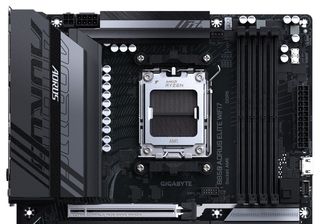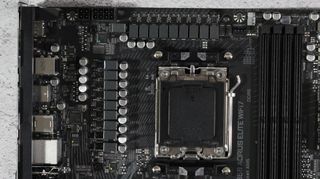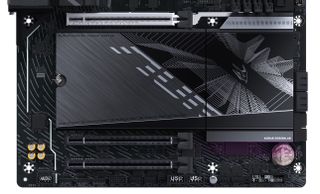In our first motherboard review of 2025, we bring you a board from the new B850 chipset in the Gigabyte B850 Aorus Elite Wifi7. The new chipset offers users a less expensive way into AM5, at least when talking about the 800 series, and has many features we like. That said, it is a value-proposition chipset; ultimately, there are some sacrifices here compared to X870/E.
The B850 chipset differs from X870E/X870 in a few noticeable ways. First, PCIe 5.0 is now optional for graphics. In other words, it depends on the motherboard if your primary PCIe graphics slot is 5.0-capable. The good news is that all boards will have at least one PCIe 5.0-capable M.2 socket. USB connectivity also changes because USB4 is not mandatory, but 3.2 Gen 2x2 (20 Gbps) is. So, if you need 40 Gbps via USB on this platform, you must look closely at the specifications or buy an expansion card. That out of the way, you can still overclock the CPU and memory, but B840 is memory only (among other changes).
Gigabyte hits the ground running on B850 with 11 different motherboards of varying shapes, sizes, and price points. At the top of the list is the AI Top ($349.99), followed by the Aorus Elite Wifi7 (and Ice version) for $229.99. The company also has multiple Micro-ATX offerings ($129.99-$199.99) and even a Mini-ITX board, the B850I Aorus Pro ($279.99). There’s something for everyone in this product stack.
Our B850 Aorus Elite Wifi7 is a good-looking ATX-size board that offers users Wi-Fi 7, a DIY-friendly design, three M.2 sockets (one 5.0 x4), and ample USB ports. With a price of $229.99, it’s not a bad deal, so long as you aren’t missing native 40 Gbps USB ports and don’t mind the limited bandwidth PCIe 3.0 x1 in the other two PCIe slots. On the performance front, the B850 Aorus Elite Wifi7 did well overall across the testing suite, even leading the (more expensive) pack in a few.
Below, we’ll examine the board's details and determine whether it deserves a spot on our Best Motherboards list. But before we share test results and discuss details, we’ll list the specifications from Gigabyte’s website.
Specifications of the Gigaybte B850 Aorus Elite Wifi 7
Swipe to scroll horizontally
| Socket | AM5 (LGA 1718) |
| Chipset | B850 |
| Form Factor | ATX |
| Voltage Regulator | 18 Phase (14x Vcore, 80A DrMOS MOSFETs for Vcore) |
| Video Ports | (1) DisplayPort (v1.4) |
| USB Ports | (1) USB 3.2 Gen 2x2 (20 Gbps) Type-C |
| Row 6 - Cell 0 | (2) USB 3.2 Gen 2 (10 Gbps) |
| Row 7 - Cell 0 | (5) USB 3.2 Gen 1 (5 Gbps) |
| Row 8 - Cell 0 | (4) USB 2.0 (480 Mbps) |
| Network Jacks | (1) 2.55 GbE |
| Audio Jacks | (2) Analog + SPDIF |
| Legacy Ports/Jacks | ✗ |
| Other Ports/Jack | ✗ |
| PCIe x16 | (1) v5.0 (x16) |
| Row 14 - Cell 0 | (2) v3.0 (x1) |
| PCIe x8 | ✗ |
| PCIe x4 | ✗ |
| PCIe x1 | ✗ |
| CrossFire/SLI | ✗ |
| DIMM Slots | (4) DDR5-8200+(OC), 256GB Capacity |
| M.2 Sockets | (1) PCIe 5.0 x4 (128 Gbps) / PCIe (up to 80mm) |
| Row 21 - Cell 0 | (2) PCIe 4.0 x4 (64 Gbps) / PCIe (up to 80mm) |
| SATA Ports | (4) SATA3 6 Gbps (Supports RAID 0/1/10) |
| USB Headers | (1) USB v3.2 Gen 2 (10 Gbps) Type-C |
| Row 24 - Cell 0 | (1) USB v3.2 Gen 1 (5 Gbps) |
| Row 25 - Cell 0 | (2) USB v2.0 (480 Mbps) |
| Fan/Pump Headers | (6) 4-Pin (CPU Fan/Water cooling/System) |
| RGB Headers | (3) aRGB Gen 2 (3-pin) |
| Row 28 - Cell 0 | (1) RGB strip (4-pin) |
| Diagnostics Panel | (1) Post Status Checker (4 LEDs) |
| Internal Button/Switch | (1) Power button |
| Row 31 - Cell 0 | (1) Reset button |
| SATA Controllers | ✗ |
| Ethernet Controller(s) | (1) Realtek 8126 (5 GbE) |
| Wi-Fi / Bluetooth | Qualcomm QCNCM865 Wi-Fi 7 - 320 MHz, 6 GHz, BT 5.3 |
| USB Controllers | ✗ |
| HD Audio Codec | Realtek ALC897 |
| DDL/DTS | ✗ / ✗ |
| Warranty | 3 Years |
Inside the Box of the Gigabyte B850 Aorus Elite Wifi7
Inside the box are a few accessories designed to help you get started without an extra trip to the store. You get a single SATA cable, the EZ Plug Wi-Fi 7 antenna, a G-Connector, an Aorus sticker, and an installation guide. It’s a far cry from what’s included with the X870E Aorus Master we reviewed, but so is the price.
Design of the Aorus Elite Wifi7

The Aorus Elite Wifi7 looks good for a budget-class motherboard. The VRM heatsinks have a lot of mass and keep the power delivery bits below running within specification. The plate-style heatsink covering the M.2 sockets sports a brushed aluminum finish on the left half and a stenciled-on design with the Aorus symbol in the middle. Those looking for RGBs need to look elsewhere or add their own via the headers. It’s not a premium look with all the exposed PCB, but neither are its competitors, so don’t hold that against it.

In the upper-left corner, we first encounter the 8-pin and 4-pin EPS connectors that power the processor. The VRM heatsinks surround them, with Aorus branding on top. A direct contact heatpipe connects the two and helps share the heat load from the MOSFETs underneath. The heatsinks do a great job of keeping the power bits below from overheating.
Past the socket on the right are four DRAM slots with the locking mechanisms at the top, where you have ample room. The board supports up to 256GB of DDR5 with speeds up to 8200 MT/s, which is plenty fast for the platform. In most cases, you’re better off around 6,000-6,400 MT/s with tight CL (think 30) rating anyway.
In the right coner, the EZ Debug Zone has small white power and reset buttons and four debug LEDs to help troubleshoot POST issues. Also in that area are the first (of three) 3-pin ARGB headers with the two others and a 4-pin RGB along the bottom edge. Control over any attached RGBs or RGB-compatible device is handled through the Gigabyte Control Center (GCC) and the RGB Fusion app.
Continuing down the edge, we find the 24-pin ATX connector, a front HDMI port that connects to their Sensor Panel Link (customizable display for system monitoring). Next to that is the front panel USB 3.2 Gen 2 (10 Gbps) port, while behind it is one of the DIY-friendly features in the PCIe EZ Latch that unlocks the graphics card clasp with a press of a button.

Power delivery on the Aorus Elite Wifi7 consists of 18 phases, with 14 dedicated to Vcore. Power heads from the 8-pin EPS (and 4-pin) connector to an 8-channel Richtek RT3678BE controller. The next stop is the 14 OnSemi 55A DrMOS MOSFETs in a ‘twin’ configuration. The 770A available to the CPU isn’t a lot, but it can handle our Ryzen 9 9900X and even higher power Ryzen 9 9950X.

Shifting focus to the bottom, we’ll start on the left side of the board, where we see a fully exposed audio section. Gigabyte uses the basic 7.1-channel ALC897 codec with four dedicated audio capacitors. It’s not the best, but it will be fine for most users.
In the middle are three full-length PCIe slots. The top slot uses Gigabyte’s Ultra Durable Armor to support heavy graphics cards. It connects through the CPU and runs up to PCIe 5.0 x16 speeds. The bottom two full-length slots connect through the chipset and run up to PCIe 3.0 x1 speeds. Note that PCIe 3.0 x1 is not a typo; bandwidth is limited compared to X870 and the PCIe 4.0 speed we’re used to seeing on that platform.
Between the first and second PCIe slots and under the M.2 Thermal Guard Ext. heatsink (with EZ-Latch Click feature) are the three M.2 sockets. The top socket connects through the CPU and is your sole PCIe 5.0 x4 (128 Gbps) slot. The other two connect through the chipset and offer PCIe 4.0 x4 (64 Gbps). All sockets support up to 110mm modules. While three isn’t the most you’ll see, it should be plenty for most users, especially those with a more modest budget like this chipset is aimed at. RAID modes weren’t listed in the materials we had available before launch.
Past the chipset, along the right edge, are the four SATA ports and a 19-pin USB 3.2 Gen 1 (5 Gbps) connector. Across the bottom of the board are several exposed headers. You’ll find the usual, including additional USB ports, RGB headers, and more. Below is a complete list from left to right.
- Front panel audio
- (2) 3-pin aRGB header
- 4-pin RGB header
- TPM Header
- (2) System Fan headers
- (2) USB 2.0 headers
- 19-pin USB 3.2 Gen 1 (5 Gbps)
- (2) System fan headers
- Front Panel header
- CMOS battery

The backplate on the B850 Aorus Elite Wifi7 has plenty of connectivity and even some ventilation ports that help to cool the VRMs by a few degrees further. The black background gives way to light grey, easy-to-read, and descriptive text. There are 11 USB Type-A ports (4x USB 2.0, 5x USB 3.2 Gen 1, 2x USB 3.2 Gen 2) and one USB 3.2 Gen 2x2 (20 Gbps) Type-C port. It’s not the fastest set of ports, but again, there’s limited bandwidth compared to X870.
To the left of the USB ports is the DisplayPort for video output and the Q-Flash Plus button. On the right, above the red 10 Gbps USB ports, is the Realtek 812 2.5 GbE port. The Wi-Fi 7 EZ-Plug is on the right, and finally, the three-plug audio stack (mic/headphones, SPDIF).
MORE: Best Motherboards
MORE: How To Choose A Motherboard
MORE: All Motherboard Content

 3 days ago
9
3 days ago
9




/cdn.vox-cdn.com/uploads/chorus_asset/file/25623086/247270_Apple_watch_series_10_AKrales_0631.jpg)



 English (US) ·
English (US) ·